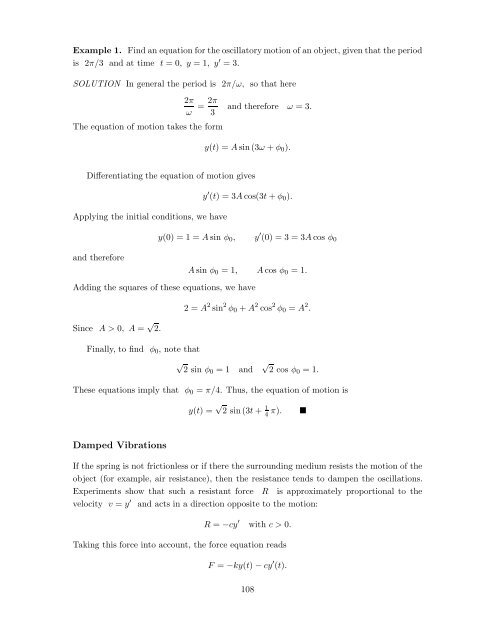Second Order Linear Differential Equations
Second Order Linear Differential Equations
Second Order Linear Differential Equations
You also want an ePaper? Increase the reach of your titles
YUMPU automatically turns print PDFs into web optimized ePapers that Google loves.
Example 1. Find an equation for the oscillatory motion of an object, given that the period<br />
is 2π/3 and at time t =0,y=1,y ′ =3.<br />
SOLUTION In general the period is 2π/ω, so that here<br />
2π<br />
ω<br />
= 2π<br />
3<br />
The equation of motion takes the form<br />
and therefore ω =3.<br />
y(t) =A sin (3ω + φ0).<br />
Differentiating the equation of motion gives<br />
Applying the initial conditions, we have<br />
and therefore<br />
y ′ (t) =3A cos(3t + φ0).<br />
y(0) = 1 = A sin φ0, y ′ (0) = 3 = 3A cos φ0<br />
A sin φ0 =1, Acos φ0 =1.<br />
Adding the squares of these equations, we have<br />
Since A>0, A= √ 2.<br />
2=A 2 sin 2 φ0 + A 2 cos 2 φ0 = A 2 .<br />
Finally, to find φ0, note that<br />
√<br />
2 sin φ0 = 1 and √ 2 cos φ0 =1.<br />
These equations imply that φ0 = π/4. Thus, the equation of motion is<br />
Damped Vibrations<br />
y(t) = √ 2 sin (3t + 1 4<br />
π). <br />
If the spring is not frictionless or if there the surrounding medium resists the motion of the<br />
object (for example, air resistance), then the resistance tends to dampen the oscillations.<br />
Experiments show that such a resistant force R is approximately proportional to the<br />
velocity v = y ′ and acts in a direction opposite to the motion:<br />
R = −cy ′ with c>0.<br />
Taking this force into account, the force equation reads<br />
F = −ky(t) − cy ′ (t).<br />
108

















